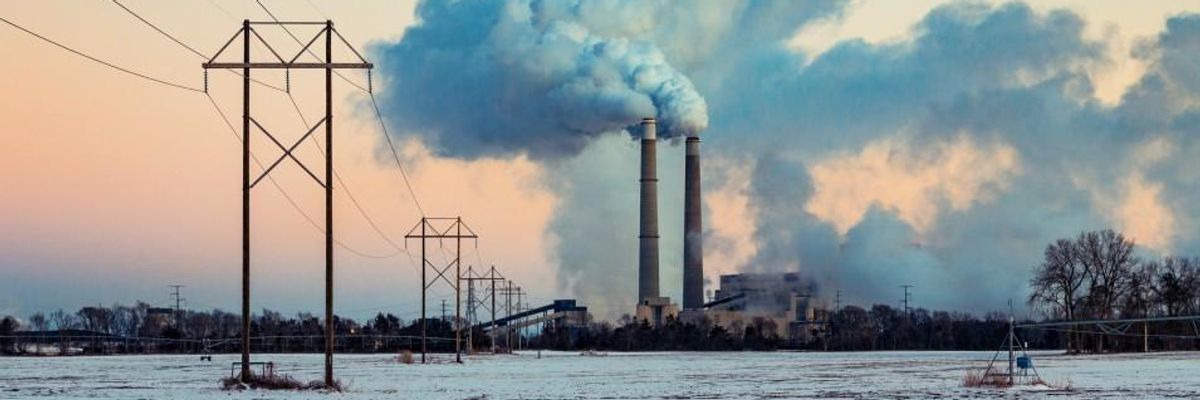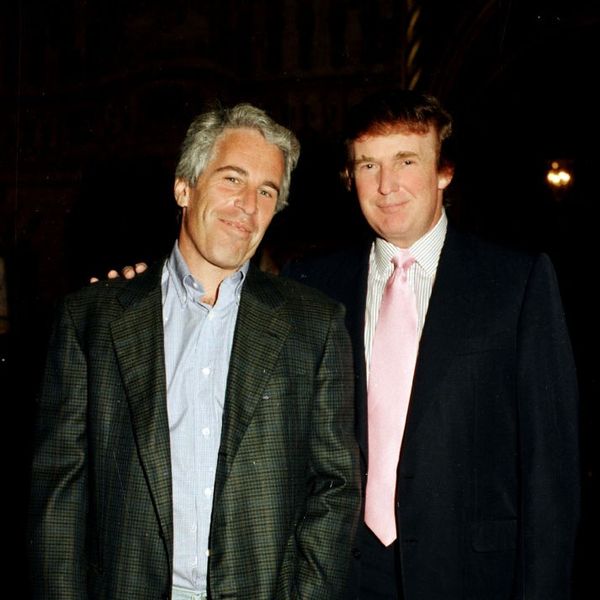
The Sherburne County (Sherco) Generating Station, a coal-fired power plant owned by Xcel Energy and located in Becker, Minnesota, shown in 2016. (Photo: Tony Webster/Flickr/cc)
Decades of Heavy Air Pollution Could Make Some Areas More Likely to See High Coronavirus Death Toll: Study
"We need to focus on fighting this pandemic now. When we get to the other side, we need to have a real and honest conversation about the failure to tackle harmful air pollution."
Decades of rising air pollution in many parts of the U.S. may make the coronavirus pandemic even more dangerous for people living in the country's most heavily polluted areas, according to a new study released by Harvard University on Tuesday.
Researchers at the T.H. Chan School of Public Health at Harvard examined data about harmful particulate matter in 3,080 counties across the country over the past 17 years and compared pollution levels with the counties' death rates thus far from COVID-19, the respiratory illness caused by the new coronavirus.
A person living for many years in a county with high levels of P.M. 2.5--tiny particles which can cause health problems when inhaled--is 15% more likely to die if they contract COVID-19, the study found, compared to people living in an area with less air pollution.
\u201cNEW: Important research from @HarvardChanSPH linking dirty air with coronavirus deaths. It's the 1st nationwide study & it finds places with even slightly higher PM 2.5 levels will likely have far higher Covid-19 death rates than less polluted areas.\nhttps://t.co/yVoWmhQoLA\u201d— Lisa Friedman (@Lisa Friedman) 1586260950
Highly polluted counties "will be the ones that will have higher numbers of hospitalizations, higher numbers of deaths, and where many of the resources should be concentrated," said Dr. Francesca Dominici, the lead author of the study, which is set to be peer-reviewed and published in the New England Journal of Medicine.
The correlation between coronavirus deaths and pollution was found even when there was only a slight increase in the amount of air pollution in a county.
A person living in an area with only one unit less of P.M. 2.5 would be 15% less likely to die of COVID-19 if they contracted it, the study found.
High levels of pollution may be responsible for thousands of deaths that would have been avoided with stronger regulations on emissions from power plants and automobiles, which are responsible for most fine particulate matter in the atmosphere, according to the report. As the New York Times reported:
The paper found that if Manhattan had lowered its average particulate matter level by just a single unit, or one microgram per cubic meter, over the past 20 years, the borough would most likely have seen 248 fewer COVID-19 deaths by this point in the outbreak.
At press time, more than 3,400 people in New York City have died of the coronavirus. The city is the 15th most polluted in the nation, according to analysis of EPA statistics.
Harvard's study was released a week after the Trump administration said it would weaken Obama-era restrictions on vehicle tailpipe emissions, even as the EPA acknowledged doing so would lead to more premature deaths associated with air pollution.
"We need to focus on fighting this pandemic now," tweeted Adriano L. Martinez, an environmental attorney in Los Angeles. "When we get to the other side, we need to have a real and honest conversation about the failure to tackle harmful air pollution."
An Urgent Message From Our Co-Founder
Dear Common Dreams reader, The U.S. is on a fast track to authoritarianism like nothing I've ever seen. Meanwhile, corporate news outlets are utterly capitulating to Trump, twisting their coverage to avoid drawing his ire while lining up to stuff cash in his pockets. That's why I believe that Common Dreams is doing the best and most consequential reporting that we've ever done. Our small but mighty team is a progressive reporting powerhouse, covering the news every day that the corporate media never will. Our mission has always been simple: To inform. To inspire. And to ignite change for the common good. Now here's the key piece that I want all our readers to understand: None of this would be possible without your financial support. That's not just some fundraising cliche. It's the absolute and literal truth. We don't accept corporate advertising and never will. We don't have a paywall because we don't think people should be blocked from critical news based on their ability to pay. Everything we do is funded by the donations of readers like you. Will you donate now to help power the nonprofit, independent reporting of Common Dreams? Thank you for being a vital member of our community. Together, we can keep independent journalism alive when it’s needed most. - Craig Brown, Co-founder |
Decades of rising air pollution in many parts of the U.S. may make the coronavirus pandemic even more dangerous for people living in the country's most heavily polluted areas, according to a new study released by Harvard University on Tuesday.
Researchers at the T.H. Chan School of Public Health at Harvard examined data about harmful particulate matter in 3,080 counties across the country over the past 17 years and compared pollution levels with the counties' death rates thus far from COVID-19, the respiratory illness caused by the new coronavirus.
A person living for many years in a county with high levels of P.M. 2.5--tiny particles which can cause health problems when inhaled--is 15% more likely to die if they contract COVID-19, the study found, compared to people living in an area with less air pollution.
\u201cNEW: Important research from @HarvardChanSPH linking dirty air with coronavirus deaths. It's the 1st nationwide study & it finds places with even slightly higher PM 2.5 levels will likely have far higher Covid-19 death rates than less polluted areas.\nhttps://t.co/yVoWmhQoLA\u201d— Lisa Friedman (@Lisa Friedman) 1586260950
Highly polluted counties "will be the ones that will have higher numbers of hospitalizations, higher numbers of deaths, and where many of the resources should be concentrated," said Dr. Francesca Dominici, the lead author of the study, which is set to be peer-reviewed and published in the New England Journal of Medicine.
The correlation between coronavirus deaths and pollution was found even when there was only a slight increase in the amount of air pollution in a county.
A person living in an area with only one unit less of P.M. 2.5 would be 15% less likely to die of COVID-19 if they contracted it, the study found.
High levels of pollution may be responsible for thousands of deaths that would have been avoided with stronger regulations on emissions from power plants and automobiles, which are responsible for most fine particulate matter in the atmosphere, according to the report. As the New York Times reported:
The paper found that if Manhattan had lowered its average particulate matter level by just a single unit, or one microgram per cubic meter, over the past 20 years, the borough would most likely have seen 248 fewer COVID-19 deaths by this point in the outbreak.
At press time, more than 3,400 people in New York City have died of the coronavirus. The city is the 15th most polluted in the nation, according to analysis of EPA statistics.
Harvard's study was released a week after the Trump administration said it would weaken Obama-era restrictions on vehicle tailpipe emissions, even as the EPA acknowledged doing so would lead to more premature deaths associated with air pollution.
"We need to focus on fighting this pandemic now," tweeted Adriano L. Martinez, an environmental attorney in Los Angeles. "When we get to the other side, we need to have a real and honest conversation about the failure to tackle harmful air pollution."
Decades of rising air pollution in many parts of the U.S. may make the coronavirus pandemic even more dangerous for people living in the country's most heavily polluted areas, according to a new study released by Harvard University on Tuesday.
Researchers at the T.H. Chan School of Public Health at Harvard examined data about harmful particulate matter in 3,080 counties across the country over the past 17 years and compared pollution levels with the counties' death rates thus far from COVID-19, the respiratory illness caused by the new coronavirus.
A person living for many years in a county with high levels of P.M. 2.5--tiny particles which can cause health problems when inhaled--is 15% more likely to die if they contract COVID-19, the study found, compared to people living in an area with less air pollution.
\u201cNEW: Important research from @HarvardChanSPH linking dirty air with coronavirus deaths. It's the 1st nationwide study & it finds places with even slightly higher PM 2.5 levels will likely have far higher Covid-19 death rates than less polluted areas.\nhttps://t.co/yVoWmhQoLA\u201d— Lisa Friedman (@Lisa Friedman) 1586260950
Highly polluted counties "will be the ones that will have higher numbers of hospitalizations, higher numbers of deaths, and where many of the resources should be concentrated," said Dr. Francesca Dominici, the lead author of the study, which is set to be peer-reviewed and published in the New England Journal of Medicine.
The correlation between coronavirus deaths and pollution was found even when there was only a slight increase in the amount of air pollution in a county.
A person living in an area with only one unit less of P.M. 2.5 would be 15% less likely to die of COVID-19 if they contracted it, the study found.
High levels of pollution may be responsible for thousands of deaths that would have been avoided with stronger regulations on emissions from power plants and automobiles, which are responsible for most fine particulate matter in the atmosphere, according to the report. As the New York Times reported:
The paper found that if Manhattan had lowered its average particulate matter level by just a single unit, or one microgram per cubic meter, over the past 20 years, the borough would most likely have seen 248 fewer COVID-19 deaths by this point in the outbreak.
At press time, more than 3,400 people in New York City have died of the coronavirus. The city is the 15th most polluted in the nation, according to analysis of EPA statistics.
Harvard's study was released a week after the Trump administration said it would weaken Obama-era restrictions on vehicle tailpipe emissions, even as the EPA acknowledged doing so would lead to more premature deaths associated with air pollution.
"We need to focus on fighting this pandemic now," tweeted Adriano L. Martinez, an environmental attorney in Los Angeles. "When we get to the other side, we need to have a real and honest conversation about the failure to tackle harmful air pollution."

